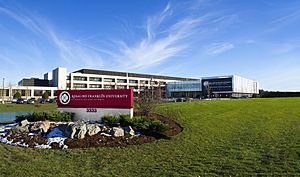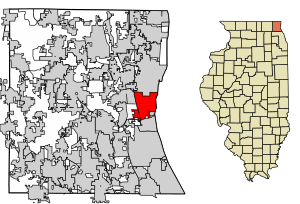North Chicago, Illinois facts for kids
Quick facts for kids
North Chicago, Illinois
|
|
|---|---|

Rosalind Franklin University of Medicine and Science
|
|

Location of North Chicago in Lake County, Illinois.
|
|
| Country | United States |
| State | Illinois |
| County | Lake |
| Area | |
| • Total | 8.02 sq mi (20.76 km2) |
| • Land | 8.00 sq mi (20.71 km2) |
| • Water | 0.02 sq mi (0.05 km2) |
| Population
(2020)
|
|
| • Total | 30,759 |
| • Density | 3,847.28/sq mi (1,485.38/km2) |
| Time zone | UTC−6 (CST) |
| • Summer (DST) | UTC−5 (CDT) |
| ZIP Code(s) |
60064, 60086, 60088
|
| Area code(s) | 847 |
| FIPS code | 17-53559 |
| Wikimedia Commons | North Chicago, Illinois |
North Chicago is a city in Lake County, Illinois, United States. It is a suburb of the Chicago metropolitan area. In 2020, about 30,759 people lived there. This makes it the third-largest city in Lake County. Only Waukegan and Mundelein have more people.
North Chicago is an important industrial area. It is home to the Great Lakes Naval Training Center. This is the only "boot camp" for new Navy members in the United States. The city also has Rosalind Franklin University of Medicine and Science, which includes the Chicago Medical School.
Contents
Discovering North Chicago's Past
People started buying land in this area in the 1890s. Soon after, industries began to grow. A train station was built in 1892. A big company called Washburn and Moen Manufacturing Company moved in. They made barbed wire.
How North Chicago Grew
The settlement became a village in 1895. Then, in 1909, it officially became a city. In 1911, a special training area for the Navy was created. This is now the Great Lakes Naval Training Center. It is the only place where new Navy recruits get their basic training.
A hospital for veterans opened in 1926. This hospital is still open today. It now works with the Naval Hospital.
A City of Many Cultures
For a long time, many immigrants from Eastern Europe lived in North Chicago. Later, during the "Great Migration", many African Americans moved here. They came from states like Arkansas and Alabama. By the end of the 1900s, they became a very well-known group in the city.
Sadly, housing was separated by race in the mid-1900s. Until 1957, the areas where African Americans lived often did not have sewers or paved roads. More recently, many Latino people have moved to North Chicago. Most of them came from Mexico. In 2020, they made up the largest group in the city. North Chicago has always been a very diverse city.
Companies and Communities
Companies like Washburn and Moen helped shape the city's different neighborhoods. Workers from other places, like Worcester, were moved here. Later, people from Sweden, Finland, and other Eastern European countries arrived.
In the northern part of North Chicago, Slovaks built the Mother of God Roman Catholic Church. They called their area "Kompanija." Further south, Polish residents started Holy Rosary Catholic Church. German and Irish families also built their own schools and churches.
Changes in the City Center
Navy members used to be a common sight in North Chicago. They would visit the "Strip," an entertainment area on Sheridan Road. But now, that area has changed. Sailors are not seen there as much. In 2007, the city tore down many old buildings on Sheridan Road. They did this to make way for new development projects.
Some movies have even been filmed on Illinois Route 137 in North Chicago. One famous movie filmed here was Groundhog Day.
Exploring North Chicago's Location
North Chicago is located at 42°19′20″N 87°51′16″W / 42.322272°N 87.854470°W.
The city covers about 7.9 square miles (20.5 square kilometers). Most of this area is land. Only a small part, about 0.015 square miles (0.04 square kilometers), is water.
North Chicago is right on Lake Michigan. It is just south of Waukegan. Most of the city's water flows directly into Lake Michigan. However, the western part of the city drains into the North Branch of the Chicago River. From there, the water eventually reaches the Illinois River. Then it flows into the Mississippi River and finally to the Gulf of Mexico.
The city also has a Lake County Forest Preserve area. It is called the Greenbelt Cultural Center and Forest Preserve.
Understanding North Chicago's Population
| Historical population | |||
|---|---|---|---|
| Census | Pop. | %± | |
| 1900 | 1,150 | — | |
| 1910 | 3,306 | 187.5% | |
| 1920 | 5,839 | 76.6% | |
| 1930 | 8,466 | 45.0% | |
| 1940 | 8,465 | 0.0% | |
| 1950 | 8,628 | 1.9% | |
| 1960 | 22,938 | 165.9% | |
| 1970 | 47,275 | 106.1% | |
| 1980 | 38,774 | −18.0% | |
| 1990 | 34,978 | −9.8% | |
| 2000 | 35,918 | 2.7% | |
| 2010 | 32,574 | −9.3% | |
| 2020 | 30,759 | −5.6% | |
| U.S. Decennial Census 2010 2020 |
|||
North Chicago has seen its population change over the years. In 2020, the city had 30,759 people. This was a decrease from 32,574 people in 2010.
Who Lives in North Chicago?
The city is known for its diverse population. In 2020, the largest group was Hispanic or Latino, making up about 36% of the population. People who identify as White made up about 26.5%. Black or African American people were about 26.9%. Other groups, including Asian and Mixed race, also live in North Chicago.
In 2000, there were 35,918 people in the city. The average household had about 3 people. Many households had children under 18 living with them. The median age in the city was 22 years old. This means half the people were younger than 22 and half were older.
It's important to know that the population numbers for North Chicago include people living at the Great Lakes Naval Training Center.
Learning in North Chicago
North Chicago Community Unit School District 187 runs the public schools in the city. North Chicago High School is the main high school for students in North Chicago.
Getting Around North Chicago
North Chicago has good transportation options. Two Metra train stations serve the city: the North Chicago station and the Great Lakes station. These trains travel south to Chicago and north to Kenosha.
Pace also provides bus service. These buses connect North Chicago to Waukegan and other nearby places.
Main Roads in the City
Famous People from North Chicago
Many notable people have connections to North Chicago:
- Tiffany Brooks is an HGTV television personality. She won Design Star, Season 8. She went to North Chicago Community High School.
- Douglas B. Green is a country musician. He is a guitarist for Riders In The Sky. He was born in North Chicago.
- John S. Matijevich was an Illinois state representative. He was born in North Chicago.
- Quincy Miller is a college basketball player.
- O'Brien Schofield is a former football player for the Wisconsin Badgers and the NFL.
- Tyrone Smith is an Olympic long jumper. He attended North Chicago Community High School.
- Michael Turner played American Football for the San Diego Chargers and Atlanta Falcons. He also attended North Chicago Community High School.
- Johnny Johnson is a former NFL quarterback and University of Illinois Quarterback. He attended North Chicago Community High School.
See also
 In Spanish: North Chicago (Illinois) para niños
In Spanish: North Chicago (Illinois) para niños

